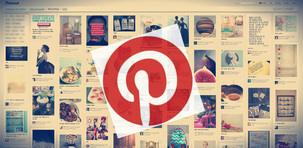
Pinterest is also a great tool for storing blog posts, websites, and all those useful articles you read online and then can never find again.
Surprisingly, it's only relatively recently that people have begun to use Pinterest as a marketing tool. (When I started using Pinterest, there were no ads!)
To be honest, while Pinterest has great potential, it's not as easy to use as Facebook or Twitter. As a form of social media, it's a little awkward, and there is much less likelihood of something going "viral." However, Pinterest has certain advantages shared by no other form of social media.
- It's easier to find information on a page of images than on a timeline
- Pins can be arranged thematically. This makes it easier to group specific types of information
- Images are memorable. An image that is interesting is more likely to catch a reader's attention than text
- Pinterest is highly addictive. Users re-pin images like mad, and they tend to stay on Pinterest longer, as well as visit it more frequently
How to use Pinterest
1. Set up your profile. Your full profile will appear on your home page, so design it carefully. First, upload an attractive, colorful image. (Square is best, as it will end up as a circle.) You can provide your location, your website (a must!), and a short bio. The bio is very important. Make sure you mention your publications, genre, and anything else potential readers might be interested in. For contact information include your Twitter handle.
2. Get followers. Like any other form of social media, you can get followers on Pinterest. There are several ways to go about this:
- Include a Pinterest follow button on your blog posts
- Add a profile widget to your blog. This also leads visitors to your Pinterest page. But it is more comprehensive than the follow button because it’s bigger and can display up to 30 of your latest pins. (I have gotten significantly more followers from the widget than from the button.)
- Make sure to include your Pinterest link to all your other social accounts
- Follow. Received wisdom is to follow 200 boards, then wait to see who follows you back and drop anyone who doesn't respond. The way you find boards to follow is by typing keywords into the search bar. Follow any boards that share your interests. (There are numerous writing boards. )
You can also broaden your audience by using the Keyword Tool. This allows you to search for the most popular keywords on Google, YouTube, Amazon, and Bing. An added feature of this tool is that it allows you to search by country and language.
4. Set up collaborative boards. Pinterest allows pinners to set up boards that allow many contributors. Some of these boards have hundreds of thousands of followers. (To find collaborative boards, go to Pin Groupie, a site that allows you to search collaborative boards by topic, number of followers, and number of pinners.) Increasing the number of pinners will increase your visibility. You can invite collaborators by email address or name. (Click the Invite button on the upper right to view your options.) You will have to follow one another to collaborate on a board.
If you want to join an established board, some collaborative boards provide contact information in the description. Check Pin Groupie for collaborative boards in your category to see which ones accept new pinners. (You can search for "writers," "writing," "authors" for general boards, or search your genre for more specific ones.)
5. Choose your images wisely. Pinterest is a visual medium. So, spend some time finding a captivating image for your pin. (See 43 Sites Where You Can Get Fabulous Free Photos for some great free sources.) The optimum image size is 600 x 800. It will resize down to 192 x 256, but will be restored to its full size when it is clicked. (If you are using Blogger, set your image size to large.)
Infographics have a great deal of success on Pinterest, as do images that also contain written information. Images that are informative as well as eye-catching will warrant more than a quick glance, and drive more traffic to your blog, story, or article.
Helpful articles:
All About Boards - Basic information about Pinterest boards.
12 Ways to Get More Pinterest Followers
How To Use Pinterest’s Group Boards To Get More Exposure For Your Business
How To Viral Market Pinterest
 RSS Feed
RSS Feed